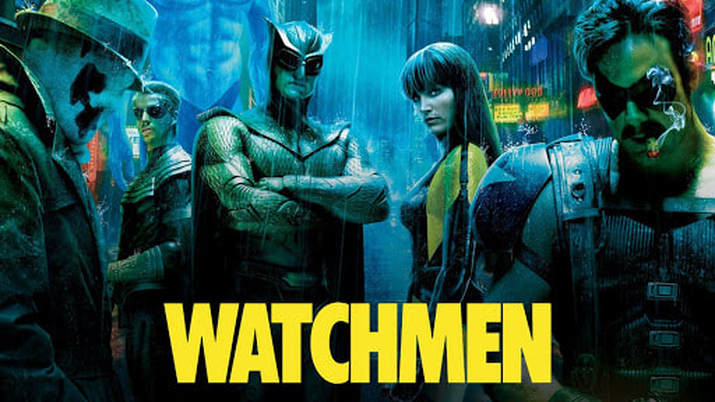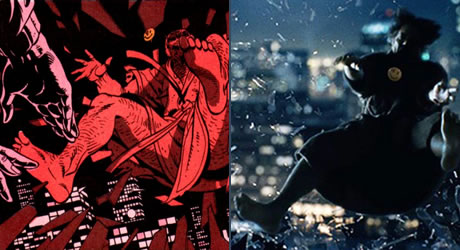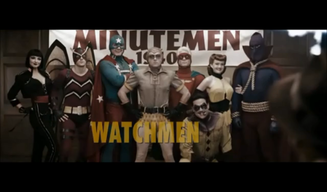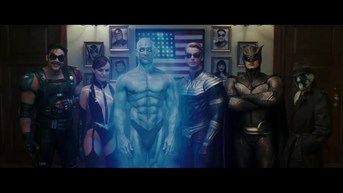In 2009, Watchmen, directed by Zack Snyder, comes closest to capturing the spirit of the original comic with its opening credit sequence. Using film language to mimic the storytelling style of comics through the combination of montage and slow motion, it condenses of themes of the film in an artistically beautiful way and pays tribute to it’s comic book origins.
To make this montage, Snyder uses a technique seen throughout Watchmen, but is most skillfully used in the opening credits: slow motion. While in the bulk of the film itself, Snyder attempts to use slow motion as a way of bringing the comic panels. With time slowed down, the framing can become still enough to linger on an image (effectively remaking the panels themselves) but remains in motion and therefore cinematic. The best example of this is recreating the panel of the Comedian (Jeffrey Dean Morgan) being thrown out of his condo through the window.
In doing this, Watchmen’s most famous exploration of the medium is condensed: the idea of superheroes removed from fantasy. What if the superhero did emerge on the verge of World War II, but not just in[HL1] comics, but reality? What kind of effect would they have on America and world history? In the sequence of events, we see the glamor of superheroes punching bank robbers and taking pictures of their meetings and celebrations, but as the montage goes on, we see the superhero Dollar Bill (Dan Payne) shot dead as the result of his cape getting stuck in the bank door, punching the myth of the superhero in the gut. Silhouette (Apollonia Vanova), is kissing a woman on the day Japan surrendered as a sailor would heroically kiss, later paying off with the image of Silhouette murdered in her bed with her lover. Mothman (Niall Matter) is dragged off to be put in an asylum. Silk Spectre’s (Carla Gugino) marriage is shown to be unhappy and argumentative. The Comedian is revealed as the assassin of JFK. As America progresses, more darkness is uncovered, as shown through the intertwining of history and superheroes.By adding the JFK assassination, references to Russia and the Cold War, and the moon landing, Watchmen juxtaposes the fantastical with reality, showing you a backstory of a world hinted at in the book with supplementary material found at the end of each issue of the original comics. Using psychiatric reports, excerpts from autobiographies and newspapers, Watchmen uses this as a way of filling out the world’s history while also juxtaposing the comic book medium with other paper-based mediums. The photography motif is its play on other visual forms as well as the use of Bob Dylan’s song, where the combination of visual and sound creates film, thereby recreating that same juxtaposition the original comic did.
While the opening credits create the past of the world it presents, it also establishes the next generation. Dr. Manhattan Billy Crudup), being the only hero in this world with actual superpowers, is connected to America’s positive aspects: the lunar landing and shaking hands with JFK. He is associated with power and accomplishment. But a hero like Rorschach (Jackie Earle Haley), alluded to with his card resembling his mask, is associated with brutality. The modern Night Owl is shown as an art piece by Andy Warhol's Campbell Soup Cans, tying into the pop culture of the world and the commodification of the super hero. Even regal presence of Ozymandias (Matthew Goode), juxtaposed with the crowded slum visually establishes Ozymandias as his namesake: a conqueror modeled after conquerors of old, looking at his “subjects” which he wants to bring to the world.
Works Cited
MOORE, ALAN. WATCHMEN. DC COMICS, 1986-1987.
Snyder, Zack, director. Watchmen. Warner Brothers, 2009.
Black, Shane, director. Iron Man 3. Walt Disney Studios Home Entertainment, 2013





 RSS Feed
RSS Feed
